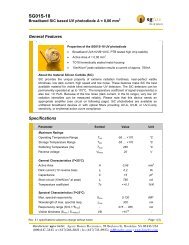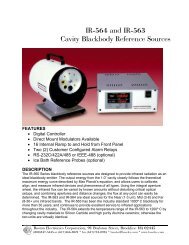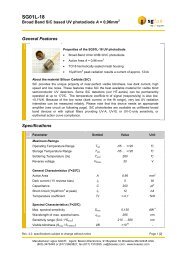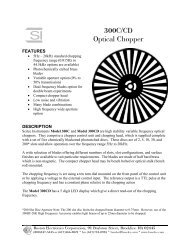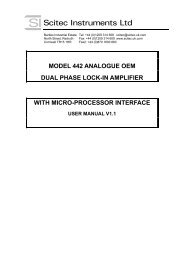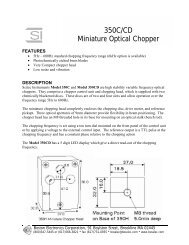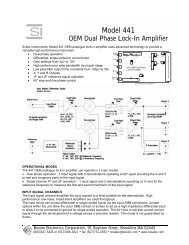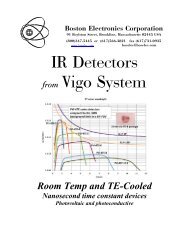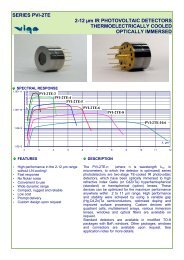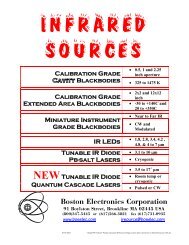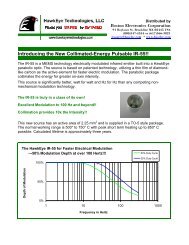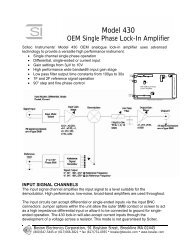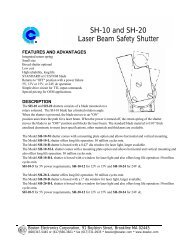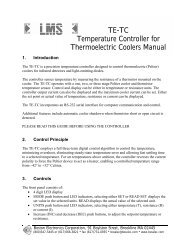TCSPC for FLIM and FRET in - Boston Electronics Corporation
TCSPC for FLIM and FRET in - Boston Electronics Corporation
TCSPC for FLIM and FRET in - Boston Electronics Corporation
Create successful ePaper yourself
Turn your PDF publications into a flip-book with our unique Google optimized e-Paper software.
molecules <strong>and</strong> are there<strong>for</strong>e double-exponential, fig. 4. Qualitative <strong>FRET</strong> results can be obta<strong>in</strong>edfrom the lifetime of a s<strong>in</strong>gle exponential approximation of the decay curve. Quantitativemeasurements require double exponential decay analysis that delivers the lifetimes, τ 0 <strong>and</strong> τ <strong>FRET</strong>,<strong>and</strong> the <strong>in</strong>tensity factors, a <strong>and</strong> b, of the two decay components [68,72]. The relative numbers ofquenched <strong>and</strong> unquenched molecules is given by the ratio of the two <strong>in</strong>tensity components, b/a,while the average coupl<strong>in</strong>g efficiency of the <strong>FRET</strong> pairs is given by τ 0 / τ <strong>FRET</strong> . In pr<strong>in</strong>ciple, both theratio of quenched <strong>and</strong> unquenched molecules <strong>and</strong> the coupl<strong>in</strong>g efficiency can be derived from as<strong>in</strong>gle donor lifetime measurement.Separation of Different ChromophoresSteady-state multi-wavelength techniques have been developed that efficiently separate differentfluorescence markers by unmix<strong>in</strong>g their fluorescence spectra [13]. However, not all markercomb<strong>in</strong>ations can efficiently be resolved. Even the well known GFP <strong>and</strong> YFP are difficult to unmix.Autofluorescence images of cells <strong>and</strong> tissue show a wide variety of fluorescence components withill-def<strong>in</strong>ed, variable, <strong>and</strong> often unknown spectra. When spectral unmix<strong>in</strong>g fails the components canusually be dist<strong>in</strong>guished by their different lifetimes [70,75]. The relative concentration of twocomponents can be determ<strong>in</strong>ed by double-exponential decay analysis. Even if only a s<strong>in</strong>gleexponential approximation, i.e. an average lifetime is measured, the contrast <strong>in</strong> the fluorescenceimages can be considerably improved. [70,75]. Moreover, changes <strong>in</strong> the relative concentration <strong>and</strong>the lifetime of autofluorescence components can possibly be used as diagnostic tools.Significant progress can be expected from comb<strong>in</strong><strong>in</strong>g spectral unmix<strong>in</strong>g <strong>and</strong> lifetime analysis.Record<strong>in</strong>g of time- <strong>and</strong> wavelength resolved data is technically possible by <strong>TCSPC</strong> techniques (see‘Multi Wavelength <strong>TCSPC</strong> Imag<strong>in</strong>g’). Comb<strong>in</strong><strong>in</strong>g the two methods requires to develop suitabledata analysis software.Diffusion <strong>in</strong> CellsDiffusion time constants <strong>in</strong> cells are usually <strong>in</strong> the ms range <strong>and</strong> below. They are usually determ<strong>in</strong>edby fluorescence correlation (FCS) techniques [14,15,16]. The problem is that the correlationtechnique is a s<strong>in</strong>gle po<strong>in</strong>t measurement. Moreover, the measurement is usually not done <strong>in</strong> thesame setup as the cell imag<strong>in</strong>g. This makes it difficult to identify the measured spot <strong>in</strong> a particularcell with sufficient accuracy. Basically the photon count<strong>in</strong>g techniques used <strong>for</strong> lifetimemeasurement are able to run a comb<strong>in</strong>ed FCS <strong>and</strong> lifetime measurement at a s<strong>in</strong>gle, well def<strong>in</strong>edpo<strong>in</strong>t of the sample. This could not only help to solve the position<strong>in</strong>g problem but also to identifys<strong>in</strong>gle marker molecules [17] <strong>and</strong> to reveal con<strong>for</strong>mational changes of the diffus<strong>in</strong>g marker/prote<strong>in</strong>clusters [18]. Although appropriate photon counters are available [63] no comb<strong>in</strong>ed <strong>FLIM</strong> / FCSsetup has become known yet.5



